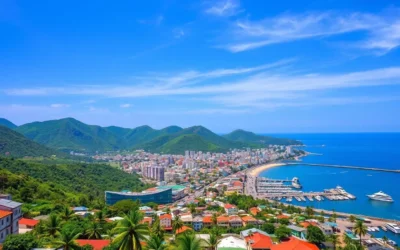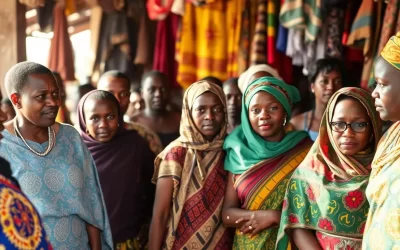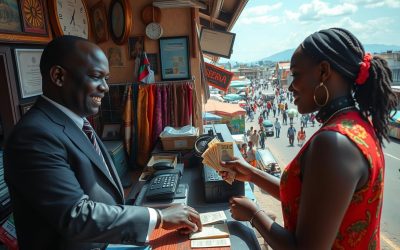✓ Accommodations ✓ Flights ✓ Rental Cars
Are you ready to explore a hidden gem on Africa’s West Coast? Freetown, the capital of Sierra Leone, offers a unique blend of stunning natural beauty and rich cultural heritage. As you wander through this vibrant city, you’ll discover unforgettable experiences that await you.
This fascinating West African capital is home to diverse attractions, from wildlife sanctuaries to historical sites that tell the story of the country’s complex past. The beautiful beaches along Sierra Leone’s coastline offer pristine sands and crystal-clear waters, perfect for relaxation and adventure.
As an off-the-beaten-path destination, Freetown provides authentic experiences away from mass tourism. With its unique history, stunning places, and exciting things to do, this country is a great addition to your trip guide.
Discovering the Vibrant Capital of Sierra Leone
As you step into Freetown, Sierra Leone’s capital, you’ll be greeted by a unique blend of history, culture, and natural beauty. This city is a treasure trove of experiences waiting to be uncovered.
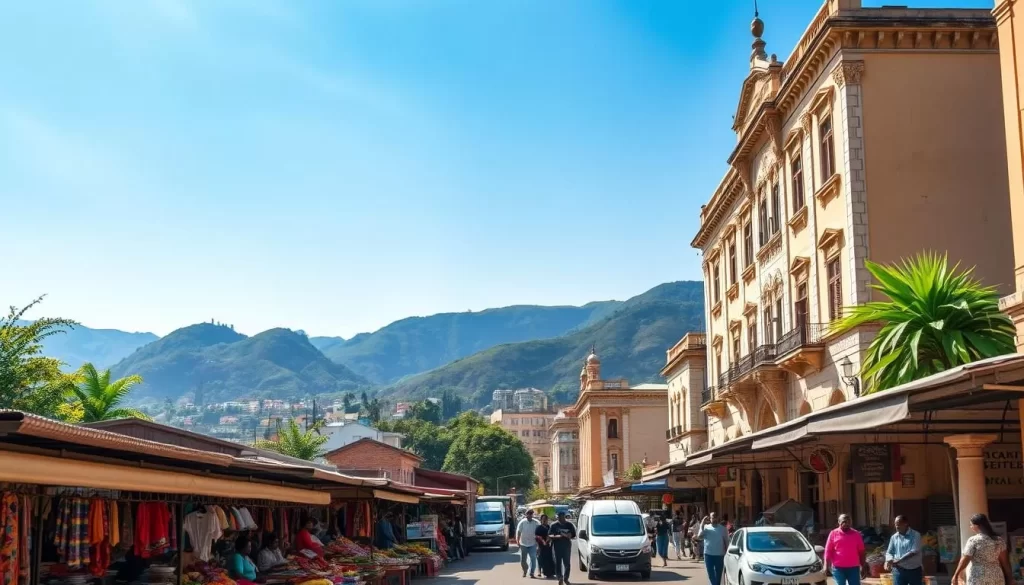
A Brief Introduction to Freetown
Freetown, founded in 1792 as a settlement for freed slaves, is a city steeped in history. Its name is a testament to its origins, and it has evolved into a cultural melting pot where various ethnic groups coexist, creating a vibrant urban atmosphere unlike any other in West Africa. The city’s strategic location on a peninsula alongside the Sierra Leone Harbor, one of the world’s largest natural harbors, has significantly shaped its development.
The harbor has not only influenced the city’s history but also its culture and economy. Today, Freetown is a place where you can experience the warmth of the Sierra Leonean people and enjoy the city’s natural beauty.
| Aspect | Description | Significance |
|---|---|---|
| History | Founded in 1792 for freed slaves | Rich historical background |
| Culture | Melting pot of ethnic groups | Vibrant cultural scene |
| Location | Peninsula alongside Sierra Leone Harbor | Strategic and scenic |
Why Freetown Should Be on Your Travel Radar
Freetown is an ideal destination for travelers seeking meaningful experiences off the beaten path. The city’s authenticity, coupled with the warmth of its people, makes it a place you will cherish. By visiting Freetown, you’re not just exploring a new country; you’re immersing yourself in a culture that is both rich and diverse.
Whether you’re drawn to its historical significance, natural beauty, or cultural richness, Freetown has a lot to offer. It’s a city that will leave you with unforgettable experiences, making it a must-visit destination in Sierra Leone.
Tacugama Chimpanzee Sanctuary: A Conservation Success Story
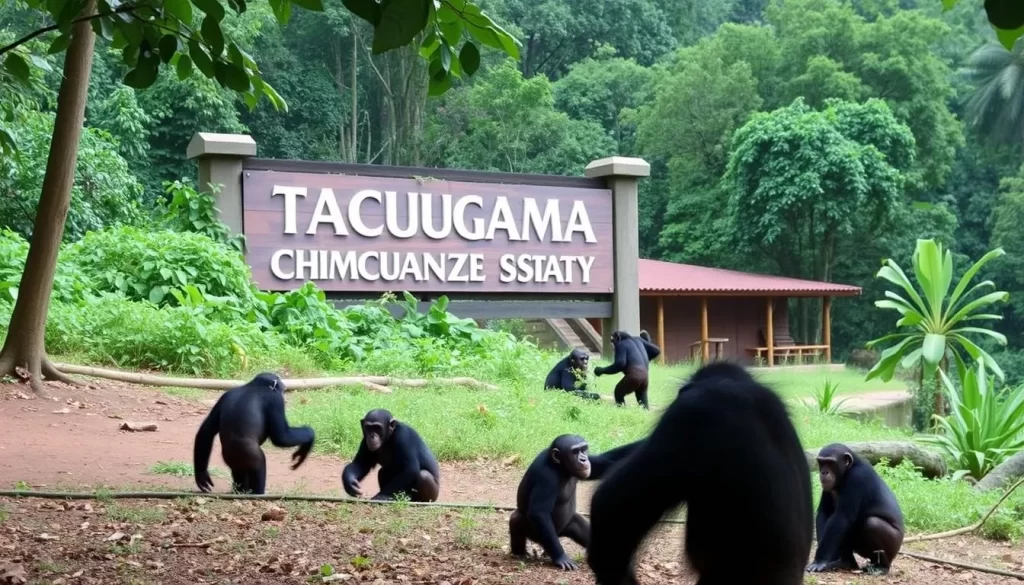
The Tacugama Chimpanzee Sanctuary, situated near Freetown, is a haven for rescued chimpanzees and a testament to conservation efforts in Sierra Leone. Located just 25 minutes outside Freetown, this sanctuary is a vital conservation center for the country’s endangered chimpanzee population.
Meeting Sierra Leone’s Rescued Chimpanzees
At Tacugama, you will have the opportunity to meet the rescued chimpanzees that have been rehabilitated and are now living in protected multi-acre forests. The sanctuary’s mission is to rescue and rehabilitate injured and orphaned chimpanzees, providing them with a safe haven. Unfortunately, due to the ongoing threat of hunting for bushmeat, the chimpanzees cannot be fully released back into the wild.
During your visit, you will learn about the sanctuary’s comprehensive approach to conservation, including education programs aimed at local communities to reduce hunting and habitat destruction.
Conservation Efforts and Visitor Information
The Tacugama Chimpanzee Sanctuary is not just a place to visit; it’s a wildlife conservation effort that you can be a part of. Here are some key highlights and visitor information:
- Explore the chimpanzee sanctuary, located just 25 minutes outside Freetown.
- Learn about the sanctuary’s mission to rescue and rehabilitate injured and orphaned chimpanzees.
- Discover the challenges facing chimpanzees in Sierra Leone, including hunting for bushmeat.
- Understand the sanctuary’s comprehensive approach to conservation.
- Get practical visitor information, including the entry fee (approximately 200,000 leones or $11), opening hours (Monday to Saturday, 9 AM to 5 PM, closed on Sundays), and how to arrange transportation to the Tacugama Chimpanzee Sanctuary.
By visiting this place, you are supporting conservation efforts and contributing to the protection of wildlife in Sierra Leone.
Exploring Sierra Leone’s Haunting Slave Trade History
As you explore Sierra Leone, you’ll uncover a history that is both haunting and hopeful, particularly in its connection to the slave trade. The country’s past is marked by its significant role in the transatlantic slave trade, a legacy that continues to shape its identity today.
Bunce Island: Gateway to the Transatlantic Slave Trade
Bunce Island is a poignant historical site that served as a major slave trading post between the 17th and 19th centuries. Tens of thousands of enslaved Africans were held here before being shipped across the Atlantic, leaving an indelible mark on the history of Sierra Leone.
Visiting Bunce Island allows you to delve into Sierra Leone’s profound connection to the transatlantic slave trade. The haunting ruins of the fort stand as a somber reminder of this dark period, providing insights into the mechanics of the slave trade.

The Cotton Tree: Symbol of Freedom in Freetown
In the heart of Freetown stands the iconic Cotton Tree, a symbol of freedom and hope. This historic landmark marks the spot where freed slaves gathered upon their return to Africa, signifying a new beginning.
The Cotton Tree is not just a historical relic; it represents the resilience and strength of those who were enslaved and later freed. It stands as a powerful reminder of Sierra Leone’s complex history and its role in both the slave trade and the return of freed slaves.
Understanding Sierra Leone’s history, including its connection to the slave trade and the significance of places like Bunce Island and the Cotton Tree, provides a deeper appreciation of the country’s unique narrative. Additionally, learning about other significant departure points like the Banana Islands adds another dimension to your understanding of this complex historical period.
Sierra Leone National Museum: Journey Through Time
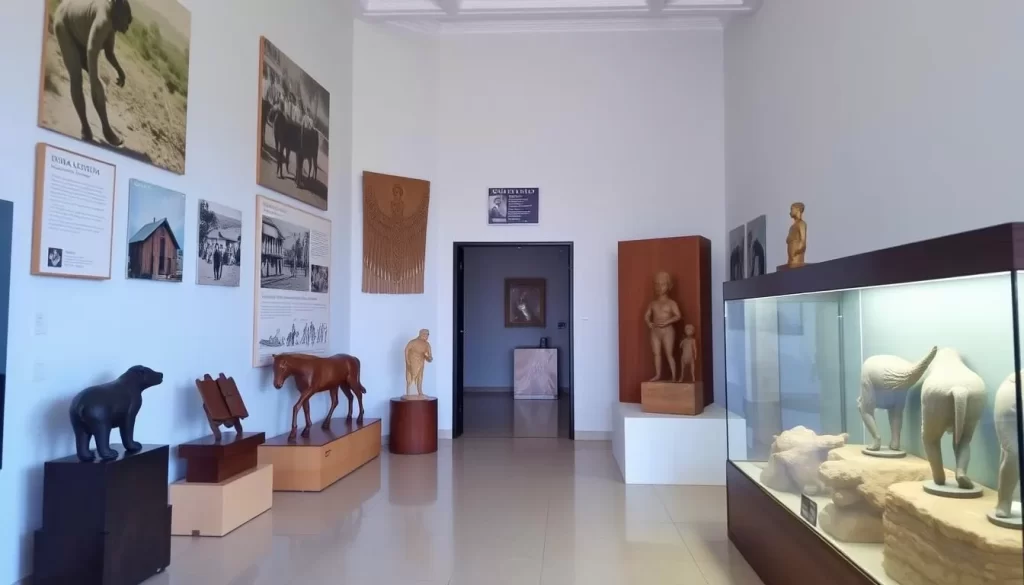
Located in the heart of Freetown, the Sierra Leone National Museum offers a journey through time, showcasing the nation’s rich cultural heritage and complex history. As you step into the museum, you are greeted by a comprehensive collection of artifacts that tell the story of Sierra Leone‘s past, from pre-colonial times to the present day.
Exhibits Highlighting Sierra Leone’s Rich Heritage
The museum houses an impressive array of exhibits, including traditional masks, musical instruments, and ceremonial objects from various ethnic groups. These artifacts provide valuable insights into Sierra Leone’s diverse cultural landscape. You can learn about the country’s pre-colonial history, its colonial period, the independence movement, and more recent events, including the civil war, through thoughtfully curated displays.
The exhibits not only highlight the country’s culture and history but also serve as an important educational resource for both locals and visitors, preserving Sierra Leone’s cultural identity for future generations.
Practical Information for Visitors
To plan your visit to the Leone National Museum, here is some essential information: the museum is centrally located, making it easily accessible from most parts of Freetown. You can check the opening hours and admission fees in advance. Guided tour options are available, offering a deeper understanding of the exhibits and the history they represent.
By visiting the Sierra Leone National Museum, you contribute to the preservation of the nation’s heritage and gain a deeper understanding of the country’s complex past and vibrant culture.
Beach Paradise: Freetown’s Stunning Coastal Escapes
Freetown’s coastline is a treasure trove of stunning beaches, each with its own unique charm. The city’s beaches are a perfect blend of natural beauty, vibrant culture, and relaxation, making them a must-visit destination for any traveler.
Lumley Beach: The Urban Shoreline Experience
Lumley Beach is Freetown’s urban shoreline, known for its lively atmosphere and beachside restaurants. It’s a popular gathering spot for locals, especially on weekends, offering a taste of the local culture and cuisine.
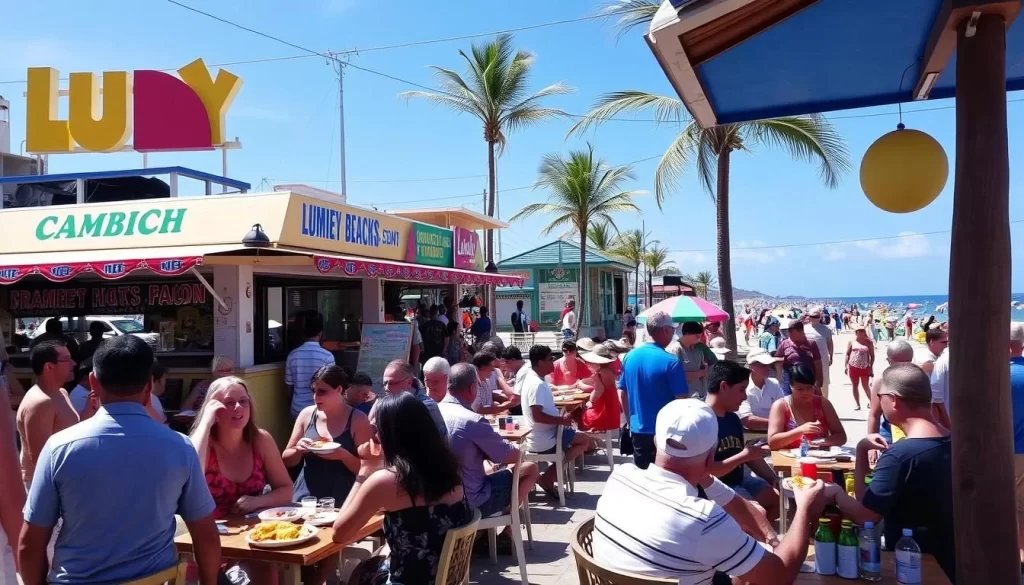
River No.2 Beach: Picturesque Estuary Views
River No.2 Beach is a picturesque coastal area where the river estuary creates shallow turquoise waters and sandbanks. It’s perfect for swimming and relaxation, making it a favorite among locals and visitors alike.
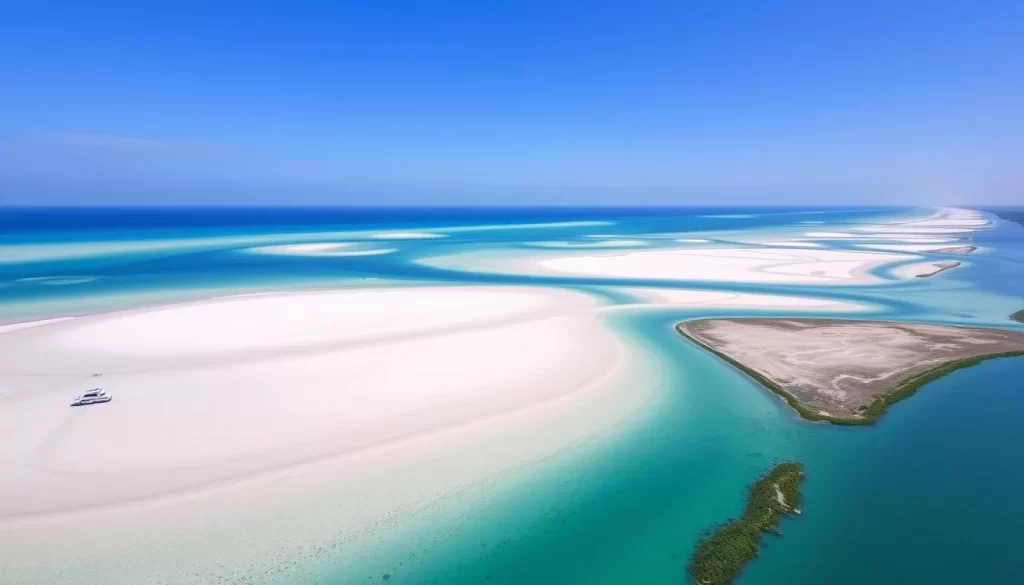
John Obey Beach: Untouched Sands and Mountain Backdrops
Located about an hour from Freetown, John Obey Beach boasts untouched sands with gorgeous mountainous backdrops, making it an ideal spot for photography and peaceful contemplation. It’s a serene escape from the city’s hustle and bustle.
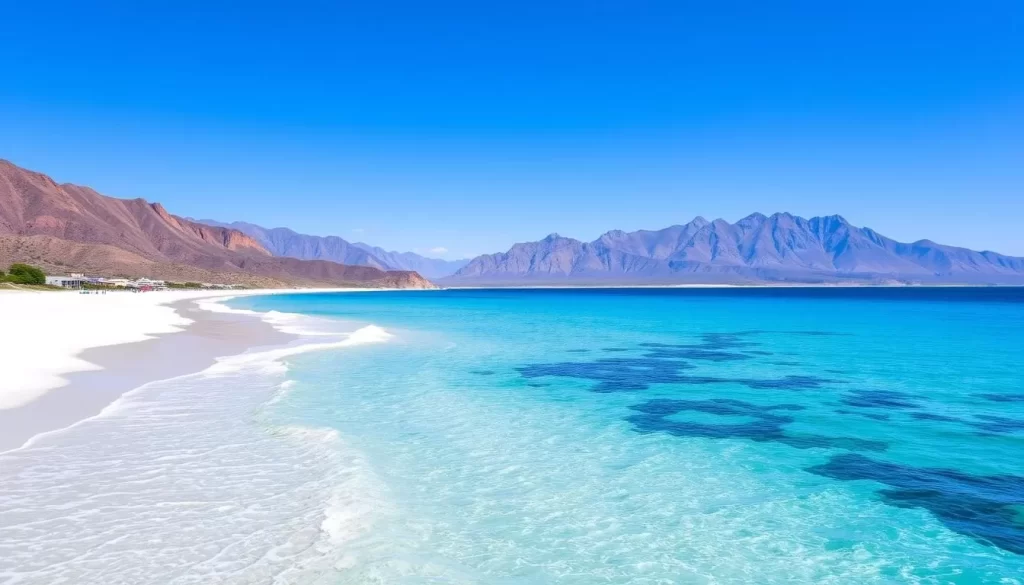
Tokeh Beach: White Sands and Turquoise Waters
Tokeh Beach is famous for its white sands and crystal-clear turquoise waters, offering a more secluded experience. Visitors can enjoy swimming, sunbathing, and savoring fresh seafood at local beachside restaurants.
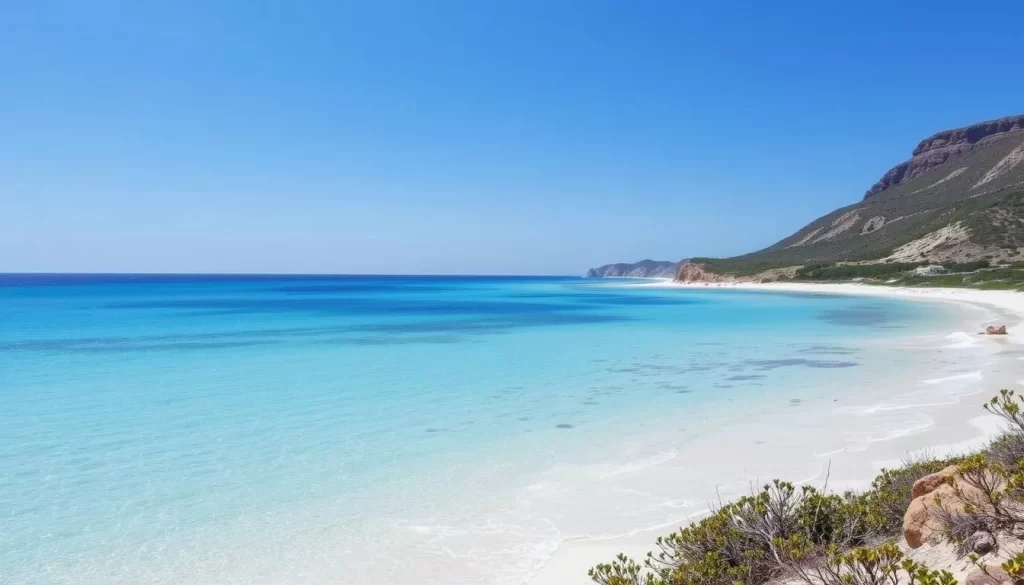
Each of these beaches offers a unique experience, from the lively atmosphere of Lumley Beach to the serene beauty of John Obey and Tokeh Beaches, and the picturesque views of River No.2 Beach. Exploring Freetown’s beaches is a journey of discovery, revealing the natural beauty and charm of Sierra Leone.
Mount Bintunami: Conquering West Africa’s Highest Peak

If you’re looking for an adventure, consider climbing Mount Bintumani, West Africa’s highest peak, located in Sierra Leone. At 1,945 meters, it’s a challenging climb that requires preparation and physical endurance.
Preparing for the Challenging Climb
Before embarking on your journey, you’ll need to obtain permission from local village elders, a process that can take more than a day. Additionally, arranging guides and gathering the necessary equipment and supplies is crucial for a successful trip. This preparation is part of the adventure, ensuring that you’re ready for the challenges ahead.
What to Expect on the Two-Day Trek
The trek to the summit of Mount Bintumani is a two-day journey, with steep terrain and unpredictable weather conditions. While technical mountaineering skills are not required, the climb is still demanding due to the lack of infrastructure. However, the panoramic views from the top, overlooking Sierra Leone‘s diverse landscapes, make the effort worthwhile. You’ll need to plan for additional time to travel to and from the starting point, making the entire adventure a 4-5 day commitment.
Climbing Mount Bintumani is an adventure like no other, offering a unique experience in this beautiful place in West Africa. With proper preparation and a sense of adventure, you’ll find this journey to be an unforgettable part of your trip to Sierra Leone.
Immersive Cultural Experiences in Freetown
Immerse yourself in the rich cultural tapestry of Freetown, where the warmth of the Sierra Leone people awaits around every corner. The city’s vibrant cultural scene is characterized by its friendly locals, who are known for their resilience and genuine interest in sharing their stories with visitors.
Connecting with Friendly Locals
Connecting with the locals is a highlight of any visit to Freetown. You can explore local markets like Big Market or King Jimmy Market, where interacting with vendors allows you to practice your Krio, the local language, and gain valuable insights into daily life in Freetown. The Sierra Leonean people are known for their warm welcome and open hearts, making it easy to form meaningful connections.
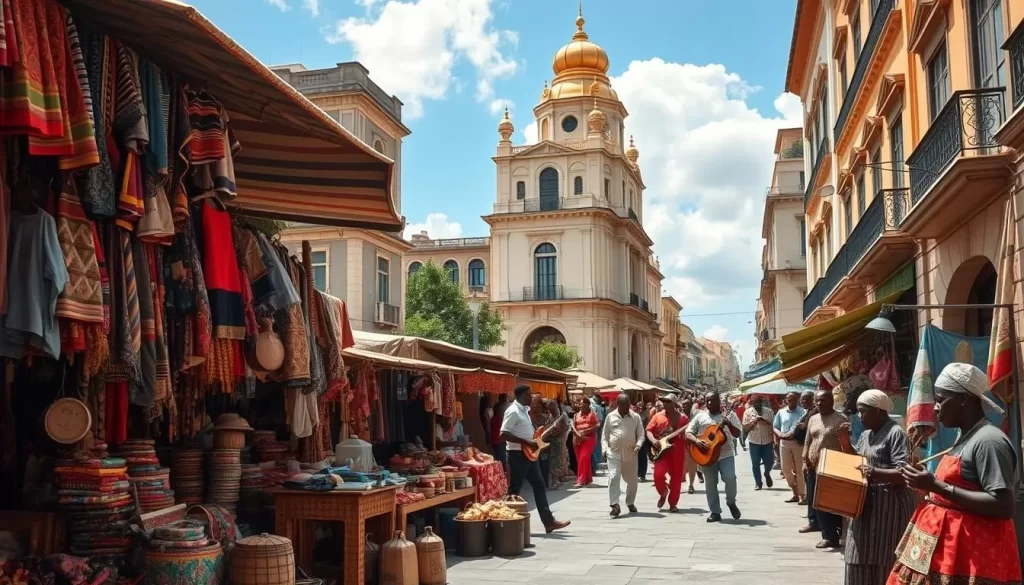
Participating in Community Activities
Participating in community activities is another way to experience the authentic culture of Sierra Leone. You can attend traditional dance performances, music events featuring local genres like “bubu” music, or religious ceremonies that showcase the spiritual diversity of the community. Visiting community centers and local NGOs provides opportunities to learn about grassroots initiatives addressing social challenges, giving you a deeper understanding of life in Freetown.
By engaging in these community activities, you’ll not only enrich your travel experience but also contribute to the local community, creating a positive impact on the people and the culture you come to admire.
Culinary Adventures: Tasting Sierra Leone’s Flavors
Discover the bold flavors and aromas of Sierra Leonean cuisine, a true West African experience. Sierra Leone’s culinary scene is a reflection of its rich cultural heritage, with dishes that are both flavorful and aromatic.
Traditional Dishes You Must Try
Sierra Leonean cuisine offers a variety of traditional dishes that are a must-try when visiting. Cassava Leaf Stew, a national favorite, is made by grinding cassava leaves and cooking them in palm oil with scotch bonnet chilies. It’s typically served over rice with chicken or smoked fish. Another dish is Granat Soup, a flavorful peanut-based curry served with rice and your choice of protein. For dessert, Coconut Cake is a sweet treat made from fresh coconut, flour, and sugar.
Cooking Classes: Learn to Make Sierra Leonean Specialties
To truly immerse yourself in Sierra Leone’s culinary culture, consider participating in a cooking class. Organizations like Salone Hidden Gems offer classes where you can learn to prepare traditional Sierra Leonean dishes. You’ll gain hands-on experience in making Cassava Leaf Stew, Granat Soup, and Coconut Cake under the guidance of experienced local cooks. This is a great way to take a piece of Sierra Leone back home with you.
By engaging in these culinary activities, you’ll not only enjoy the flavors of Sierra Leone but also gain a deeper understanding of the local culture and way of life. Whether you’re sampling street food or participating in a cooking class, your culinary adventure in Sierra Leone is sure to be a memorable experience.
Outamba-Kilimi National Park: Wildlife Safari Experience

Sierra Leone’s Outamba-Kilimi National Park is a wildlife enthusiast’s paradise, boasting diverse ecosystems and an array of exotic animals. As a premier wildlife destination, it offers a unique safari experience that showcases the country’s natural biodiversity in a less touristy setting than other African safari destinations.
Diverse Wildlife and Bird Watching Opportunities
The park is home to a wide variety of wildlife, including elephants, chimpanzees, hippos, pygmy hippopotamus, buffalo, and various monkey species. These animals inhabit the park’s varied ecosystems, ranging from savannah to riverine forests. With nearly 260 species recorded, Outamba-Kilimi National Park is also a haven for bird enthusiasts, offering exceptional bird watching opportunities.
Planning Your Safari Adventure
To make the most of your visit, plan your safari adventure carefully. The dry season, from November to April, is the best time to visit. You can choose from basic but comfortable park lodges or camping options for your stay. Guided safari tours are available, providing a deeper understanding of the park’s ecosystems and the amazing wildlife of Sierra Leone. By visiting Outamba-Kilimi National Park, you are supporting conservation efforts that protect Sierra Leone’s natural heritage and provide sustainable livelihoods for surrounding communities.
Outamba-Kilimi National Park is truly a unique place for an unforgettable experience, making it a must-visit destination for any adventure seeker or nature lover.
Turtle Islands: Off-Grid Paradise

For those seeking a true desert island adventure, the Turtle Islands in Sierra Leone are a must-visit destination. This remote archipelago, comprising eight smaller islands, is known for being one of the most unspoiled and isolated island groups in the world. The islands boast pristine white sand beaches, coconut palm-lined shores, and crystal-clear waters teeming with marine life, creating a true paradise for those looking to disconnect from the modern world.
Experiencing Life in Unwesternized Communities
The Turtle Islands are not just a natural haven but also home to a genuinely unwesternized tribe. Visitors have the unique opportunity to experience life in these traditional communities, where locals maintain their traditional ways of living, fishing, and crafting. This rare glimpse into a largely unchanged lifestyle is a significant part of the islands’ appeal, offering a chance to engage with a culture that remains untouched by the influences of modern society.
Practical Tips for Visiting the Remote Islands
Visiting the Turtle Islands requires careful planning. The journey involves a 3-hour boat ride, which necessitates booking with reputable operators who use properly equipped vessels. It’s advisable to stay for at least 2-3 days to fully immerse yourself in the islands’ rhythm of life and adjust to the absence of modern amenities. This duration allows for meaningful interactions with the local communities and a deeper appreciation of the islands’ serene beauty.
To make the most of your trip, be prepared for the challenges associated with traveling to a remote location. Ensure you have all necessary supplies and plan your itinerary carefully. The reward is an unforgettable experience in one of West Africa’s most secluded and enchanting destinations.
Freetown, Sierra Leone: Best Things to Do for History Buffs
History buffs visiting Freetown, Sierra Leone, will discover a wealth of activities that delve into the country’s complex past. The city’s historical landscape is rich and varied, offering insights into its founding, colonial era, and more recent conflicts.
Tracing the Civil War’s Impact
The Sierra Leone civil war, which lasted from 1991 to 2002, had a profound impact on the country, causing thousands of deaths and displacing millions. Visitors can explore historical sites related to this period, including the Peace Museum and various memorials throughout the city. Local guides share personal stories and insights, providing a deeper understanding of this challenging chapter in Sierra Leone’s history.
| Historical Site | Description |
|---|---|
| Peace Museum | Commemorates the lives lost during the civil war |
| Various Memorials | Located throughout the city, honoring the victims |
| Local Guides | Share personal experiences and historical context |
Colonial Architecture and Historical Sites
Freetown’s colonial past is evident in its architecture, with landmarks such as St. George’s Cathedral, Fourah Bay College, and the Law Courts building showcasing the city’s British colonial influence. Visitors can also explore the State House, the Old Wharf Steps, and the Sierra Leone Parliament building, each offering insights into different aspects of the country’s political and social development.
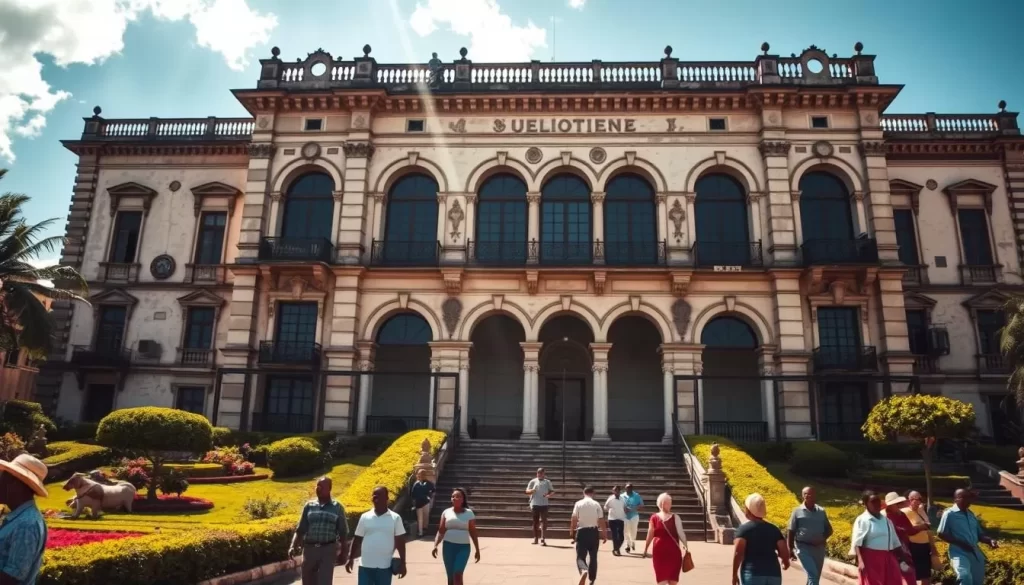
By exploring these historical sites and engaging with local guides, visitors can gain a deeper understanding of Sierra Leone’s complex history and its journey towards peace and reconciliation.
Shopping for Souvenirs: Supporting Local Artisans
Shopping for souvenirs in Freetown is not just about buying memorabilia; it’s about supporting local artisans and contributing to the community’s economic development. When you choose to shop locally, you’re directly impacting the lives of Sierra Leone’s people by fostering economic growth and preserving traditional craftsmanship.
Best Markets in Freetown
Freetown is home to vibrant markets where you can find a wide array of traditional crafts, textiles, and artwork. The Big Market, Freetown’s main market, is a must-visit place to experience the local commerce and culture. Here, you can find everything from handmade crafts to local fabrics.
For specialized craft shopping, the Cotton Tree Craft Market is a great place to explore. Artisans here sell a variety of handmade items, including wood carvings, batik fabrics, beaded jewelry, and traditional musical instruments, making it a wonderful way to support the local community.
Unique Handicrafts to Bring Home
Sierra Leone is renowned for its unique handicrafts, making it an ideal place to find special souvenirs. Some of the unique items you can bring home include country cloth (hand-woven cotton textiles), gara tie-dye fabrics in vibrant colors, soapstone carvings, and handcrafted baskets. These items not only serve as memorable souvenirs but also represent the rich cultural heritage of Sierra Leone.
By choosing to shop for these handicrafts, you’re supporting local artisans and contributing to the local community in a meaningful way. It’s a simple yet effective way to make a positive impact during your visit.
Making a Difference: Volunteer and Charity Opportunities
Freetown, the vibrant capital of Sierra Leone, offers a unique chance to engage in volunteer and charity work. Your trip to this beautiful city can be more meaningful as you participate in initiatives that benefit the local community.
The Street Child Marathon Experience
The Street Child Marathon is an annual event that raises funds to support education initiatives for vulnerable children in Sierra Leone. By participating, you’ll not only be part of a significant fundraising effort but also gain a life-changing experience as you learn about the organization’s work and meet the beneficiaries of the funds raised.
During your time with Street Child, you’ll understand how they work to get children off the streets and into education while helping parents establish sustainable businesses to support their families. This experience is a great way to give back to the community and make a positive impact during your visit.
Other Ways to Give Back During Your Visit
Apart from the Street Child Marathon, there are other volunteer opportunities available in Freetown. You can work with local NGOs focusing on healthcare, education, environmental conservation, and community development. These opportunities range from one-day experiences to longer commitments, allowing you to choose the time and level of involvement that suits your trip.
You can also consider alternative ways to give back, such as participating in beach clean-ups, supporting local schools with supplies, or contributing to community-based tourism initiatives. These actions ensure that your travel dollars benefit the local people directly and enhance your overall experience in Sierra Leone.
Practical Travel Tips for Visiting Freetown
To make the most of your visit to Freetown, it’s essential to have some practical travel tips at your disposal. Whether you’re looking to explore the city’s vibrant culture, relax on its beautiful beaches, or venture into the surrounding countryside, being prepared is key.
Best Time to Visit and Weather Considerations
The best time to visit Freetown is during the dry season, from November to April. This period offers the most comfortable conditions for traveling, with minimal rainfall. In contrast, the wet season, which spans from May to October, can make some attractions inaccessible due to heavy rains.
Accommodation Options
Freetown offers a range of accommodation options to suit different budgets. You can choose from international-standard hotels like the Radisson Blu Mammy Yoko and Bintumani Hotel, mid-range guesthouses, or budget-friendly hostels. It’s advisable to book your accommodation in advance, especially during peak tourist season.
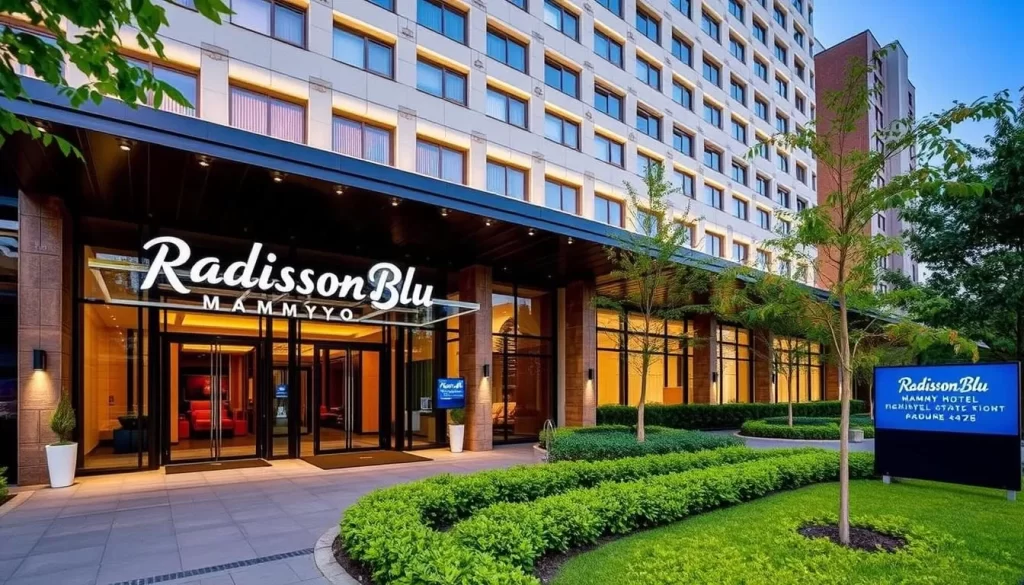
Transportation Around the City
Navigating Freetown is relatively straightforward, with various transportation options available. You can use taxis (both shared and private), motorbike taxis known as “okadas,” or “poda-podas” (minibuses). For day trips or longer excursions outside the city, consider hiring a private driver.
Health and Safety Information
Before traveling to Sierra Leone, ensure you have the necessary vaccinations, including yellow fever, which is required for entry. It’s also recommended to purchase comprehensive travel insurance and bring any essential medications, as healthcare facilities are limited. To stay safe, avoid walking alone at night, keep your valuables secure, and drink only bottled or purified water. Registering with your embassy upon arrival is also a good practice.
Planning Your Freetown Itinerary
With so many things to do in Freetown, Sierra Leone, creating an efficient itinerary is crucial to maximizing your travel experience. To make the most of your trip, you should balance cultural immersion, historical exploration, and natural beauty.
To start, consider a three-day highlights tour that covers the city’s essential experiences. On Day 1, explore the city’s historical and cultural landmarks, such as the Sierra Leone National Museum and the Cotton Tree. Day 2 can be spent visiting the Tacugama Chimpanzee Sanctuary and relaxing on Lumley Beach. On Day 3, take a day trip to River No.2 Beach, enjoying the picturesque estuary views.
Three-Day Highlights Tour
This condensed itinerary gives you a taste of Freetown’s diverse attractions. You’ll experience the city’s vibrant culture, get up close with rescued chimpanzees, and enjoy the beautiful beaches that Sierra Leone is known for.
One-Week Comprehensive Experience
If you have more time, consider expanding your itinerary to a one-week comprehensive experience. This allows you to visit Bunce Island, explore local markets, engage in community interactions, take a cooking class, and potentially take an overnight trip to the Turtle Islands or another nearby destination.
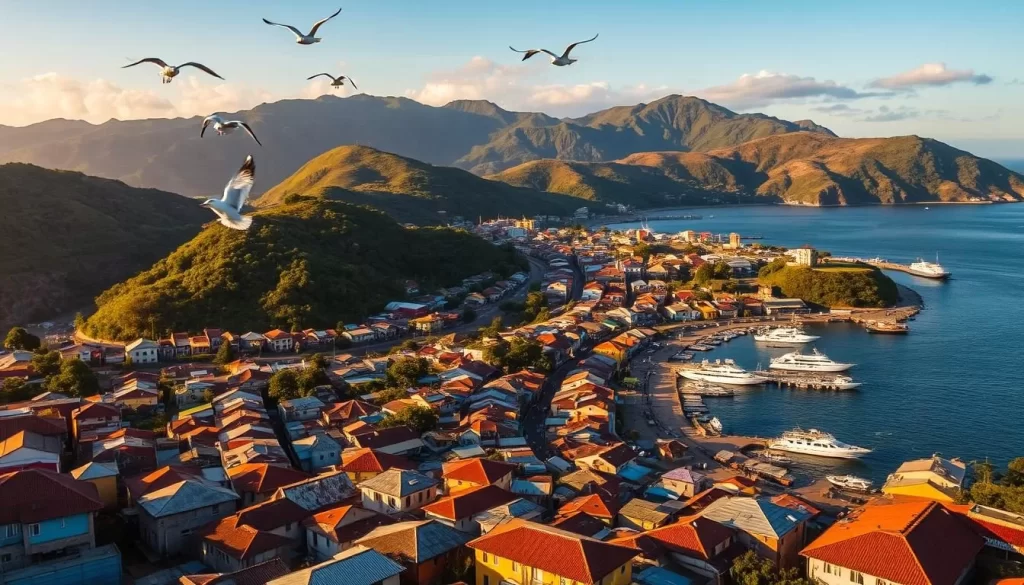
When planning your trip to Sierra Leone, be sure to consider the practical aspects, including transportation times between attractions and the local pace of life, often referred to as “Africa time.” Building flexibility into your itinerary will allow you to capitalize on unexpected discoveries or opportunities, making your travel experience even more rewarding.
Conclusion: Why Freetown Will Steal Your Heart
The moment you step into Freetown, you know you’re in for an adventure that will leave an indelible mark on your soul. Sierra Leone, with its rich history and breathtaking landscapes, is a place that will capture your heart in ways you never thought possible.
Freetown offers a unique blend of experiences, from its stunning natural beauty to its rich cultural heritage. The resilience of its people is truly inspiring, and their warmth and hospitality will leave a lasting impression on you. As you explore this relatively untouched destination, you’ll discover authentic experiences that are increasingly rare in our globalized world.
Visiting Freetown is not just about sightseeing; it’s about immersing yourself in a way of life that’s both challenging and rewarding. By engaging with the local community and supporting responsible tourism, you can contribute to Sierra Leone’s ongoing recovery and growth. This country has so much to offer, and your visit can make a real difference.
As you consider your next travel destination, remember Freetown. It’s a place that will challenge your preconceptions, create lasting memories, and potentially change your perspective on what truly matters in life. With its unique blend of history, culture, and natural beauty, Sierra Leone is a destination that will stay with you long after you’ve returned home.
In Sierra Leone, you’ll experience the best of West Africa, from its vibrant culture to its stunning landscapes. It’s a journey that will stay with you forever, a true experience that will enrich your life in ways you never imagined.
The above is subject to change.
Check back often to TRAVEL.COM for the latest travel tips and deals.


